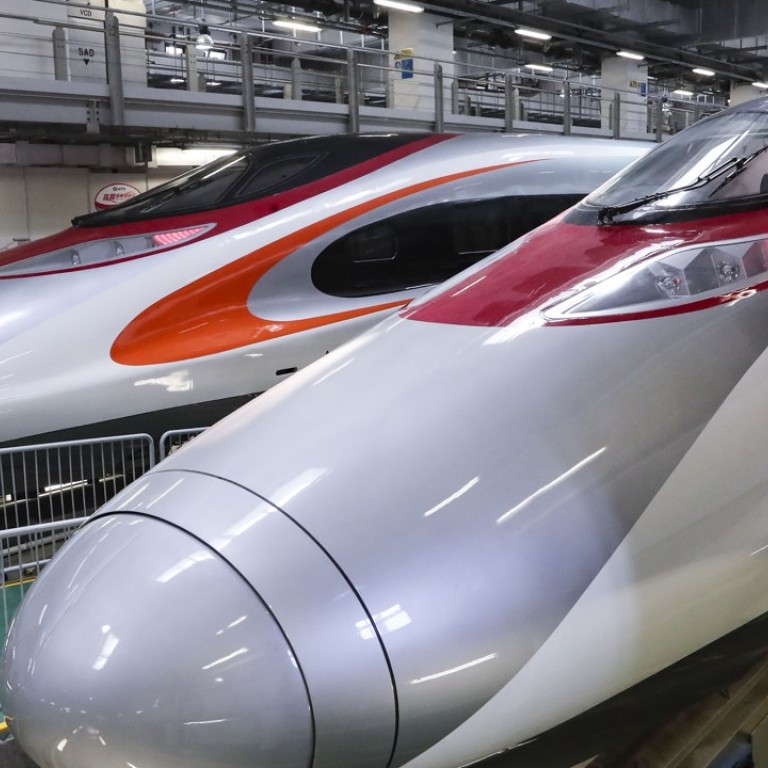
At HK$260 from Hong Kong to Guangzhou, express rail fares will cost more than earlier estimates
While critics raise concerns that travellers may seek cheaper alternatives, the government says the high-speed rail link will attract businesspeople and others seeking a faster and more comfortable journey
Travellers from Hong Kong to Guangzhou on the high-speed rail link opening later this year will have to pay HK$260 (US$33) per trip under finalised fares that are much higher than original estimates.
The 48-minute journey from the city’s West Kowloon station to Guangzhou South will cost HK$50 more than the existing – although slower – cross-border “through-train” service from Hung Hom to Guangzhou East.
Fares from West Kowloon to Futian in Shenzhen, Shenzhen North and Humen in Dongguan city will be set at HK$80, HK$90, and HK$210 respectively.
Critics of joint checkpoint rail ‘irrational’ as solid legal basis exists for plan, city’s leader says
While opposition lawmakers raised concern that the fares were not competitive enough and commuters might find them too expensive, their pro-establishment counterparts, together with the government, countered that they were reasonable and would attract business travellers and those who valued time over money.

The new fare structure is higher than the government’s previous projections, which were based partly on patronage forecasts.
After the Transport and Housing Bureau first estimated in 2009 that tickets to Shenzhen would cost HK$45 to HK$49, the figures were raised to HK$53-HK$57 in 2016. Over the same period, the estimated fare to Humen went up from HK$131 to HK$153, and to Guangzhou, from HK$180 to HK$210.
The bureau did not respond on Monday to inquiries about the justification for the higher fares, insisting instead that they were “affordable for both Hong Kong and mainland passengers”.
“Compared with travelling to Guangzhou by through-train, which costs HK$210, the express rail is attractive because of speed, level of comfort and time,” Chan said.
The through-train currently takes two hours to get passengers from Hung Hom to Guangzhou East Station, in the heart of Tianhe business district.
A full journey on the express rail will take only 48 minutes from West Kowloon, but will end at Guangzhou South Station instead, which is further away from the city centre. However, the station is positioned as a hub for the region’s high-speed rail network, meaning travellers can hop on another train and continue their journey to almost anywhere in the country.
Six things to know about Hong Kong’s controversial ‘co-location’ joint checkpoint scheme
Critics have long complained that it would be “misleading” to promote the express rail journey as being faster because most passengers would be headed for the city centre, which would require an additional commute.
Civic Party lawmaker Tanya Chan described the latest fares as “shocking”, while Democratic Party chairman Wu Chi-wai suggested that Hongkongers not living close to West Kowloon would seek cheaper options.
But tourism sector lawmaker Yiu Si-wing disagreed, arguing that Guangzhou was a huge city.
“Others may be heading to the so-called old districts of Yuexiu and Liwan, which are closer to Guangzhou [South] Station. So it is not fair to say Guanghzou South is always inconvenient,” he explained.

There would be 228 trains, or 114 pairs, running daily between Hong Kong and the four mainland stations on 130 “peak days” a year, the transport minister said. Only 30 pairs would go go to Guangzhou South and Humen in Dongguan, with the remaining 84 terminating at Futian or Shenzhen North.
Lawmaker Michael Tien Puk-sun, a former railway boss in Hong Kong, said this arrangement reflected the “real value” of the rail link.
“It is always estimated that 70 per cent of passengers head for Shenzhen only,” he pointed out, also describing fares to the mainland city that shares a border with Hong Kong as “extremely competitive”.
“At HK$80 to Futian, it may seem expensive compared to HK$40 using the MTR ... But if you take into account the one-hour time saving and translate it into money, then it is another story,” he said.
A bigger controversy dogging the HK$84.4 billion express rail link is the so-called co-location arrangement between Hong Kong and Beijing that would allow mainland officers to enforce mainland laws at part of the West Kowloon terminal leased to them.
While the government says it will enhance passenger flow, critics see it as harmful to the “one country, two systems” principle, under which Hong Kong enjoys a high degree of autonomy.



